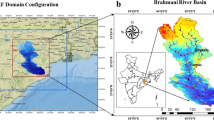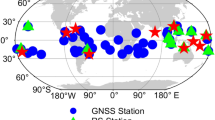Abstract
As an exercise in model sensitivity, the Models-3 Community Multiscale Air Quality (CMAQ) modeling system with meteorological fields from the Regional Atmospheric Modeling System (RAMS) was applied to study the response of photochemical oxidants to systematic increases in anthropogenic volatile organic compounds (VOC) and nitrogen oxides (NOx) emissions in January 1997 over East Asia. Three simulations-one base case and two sensitivity simulations were carried out. Two sensitivity simulations were performed by assuming a 35% separate increase in anthropogenic VOC and NOx emissions comparing with the base case. Biogenic VOC emissions were held constant across the sensitivity simulations. To evaluate the model performance, ozone mixing ratios (O3) from the base case simulation were compared with surface observations at five remote sites in Japan, and it was found that the model reproduces most of the important features in the observations. Monthly average O3 concentrations in the daytime were examined to gain an understanding of how the increase in anthropogenic emissions affected the overall chemical system for each sensitivity simulation.
Similar content being viewed by others
References
Benkovitz, C. M., M. T. Schultz, J. Pacyna, L. Tarrason, J. Dignon, et al., 1996. Global gridded inventories of anthropogenic emissions of sulfur and nitrogen. J. Geophys. Res., 101: 29 239–29 253.
Byun, D. W., and J. K. S. Ching, 1999. Science Algorithms of the EPA Models-3 Community Multi-Scale Air Quality (CMAQ) Modeling System. NERL, Research Triangle Park, NC., Nat. Acad. Press. Washington, D.C.
Carmichael, G. R., I. Uno, M. J. Phadnis, Y. Zhang, and Y. Sunwoo, 1998. Tropospheric ozone production and transport in the springtime in east Asia. J. Geophys. Res., 103: 10 649–10 671.
Carter, W. P. L., 1996. Condensed atmospheric photooxidation mechanism for isoprene. Atmos. Environment, 24: 4275–4290.
Colella, P., and P. R. Woodward, 1984. The piecewise parabolic method (PPM) for gas-dynamical simulations. J. Comp. Phys., 54: 174–201.
Gery, M. W., G. Z. Whitten, J. P. Killus, and M. C. Dodge, 1989. A photochemical mechanism for urban and regional scale computer modeling. J. Geophys. Res., 94: 12 925–12 856.
Kleinman, L. I., 1994. Low- and high-NOx tropospheric photochemistry. J. Geophys. Res., 99: 16 831–16 838.
Kleinman, L. I., 1991. Seasonal dependence of boundary layer peroxide concentration: the low- and high-NOx regimes. J. Geophys. Res., 96: 20 721–20 734.
Liu, S. C., 1996. Model study of tropospheric trace species distributions during PEM-West A. J. Geophys. Res., 101: 2073–2085.
Luo, C., J. C. St. John, Z. Xiuji, K. S. Lam, T. Wang, et al. 2000. A nonurban ozone air pollution episode over eastern China: Observations and model simulations. J. Geophys. Res., 105: 1889–1908.
National Academy of Sciences (NAS), 1991. Rethinking the Ozone Problem in Urban and Regional Air Pollution. Nat. Acad. Press, Washington, D.C., 489 pp.
Oliver, J. G. J., A. F. Bouwman, C. W. M. van der Mass, J. J. M. Berdowski, C. Feldt, et al., 1996. Description of EDGAR Version 2.0: A set of global emission inventories of greenhouse gases and ozone-depleting substances for all anthropogenic and most natural sources on a per country basis and on 1o×1o grid. National Institute of Public Health and the Environment (RIVM) report No. 771060 002/(TNO-MEP) report No. R96/119, Nat. Acad. Press. Washington, D. C.
Pielke, R. A., W. R. Cotton, R. L. Walko, C. J. Tremback, W. A. Lyons, et al., 1992: A comprehensive meteorological modeling system-RAMS. Meteorol. Atmos. Phys., 49: 69–91.
Sillman, S., 1995. The use of NOy, H2O2, and HNO3 as indicators for ozone-NOx-hydrocarbon sensitivity in urban locations. J. Geophys. Res., 100: 14 175–14 188.
Sillman, S., 1991. A numerical solution to the equations of tropospheric chemistry based on an analysis of sources and sinks of odd hydrogen. J. Geophys. Res., 96: 20 735–20 744.
Uno, I., S. Wakamatsu, H. Ueda, K. Murano, S. Sakamaki, et al., 1997. Behavior of secondary pollutants and volcanic SO2 over Kyushu during a spring high pressure system (in Japanese). J. Jpn. Soc. Atmos. Environment., 32: 404–424.
Author information
Authors and Affiliations
Corresponding author
Rights and permissions
About this article
Cite this article
Meigen, Z., Uno, I. Role of anthropogenic volatile organic compounds and nitrogen oxides as ozone precursors in the wintertime over East Asia. J Ocean Univ. China 1, 45–49 (2002). https://doi.org/10.1007/s11802-002-0029-1
Received:
Accepted:
Issue Date:
DOI: https://doi.org/10.1007/s11802-002-0029-1




